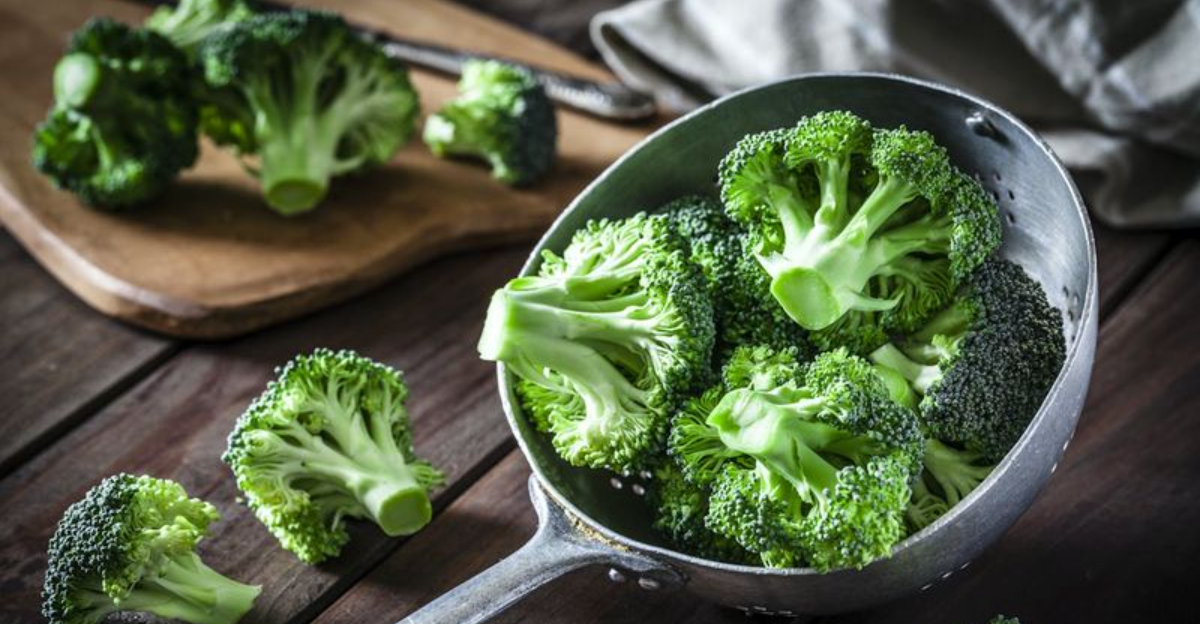18 Veggies Packed With Nutrients You Can’t Afford To Skip

Vegetables are nature’s multivitamins, packed with essential nutrients our bodies crave. Yet many of us stick to the same few options, missing out on a rainbow of health benefits.
Adding variety to your plate isn’t just good for your body but can transform your meals from boring to brilliant. Ready to supercharge your diet with nature’s most powerful plants?
1. Kale: The Crowned Leafy Champion
Move over spinach, kale wears the nutritional crown these days! This curly green powerhouse delivers an incredible amount of vitamin K, A, and C in every crunchy bite.
I started growing kale in my tiny balcony garden last summer, and even my veggie-skeptic nephew asks for ‘dinosaur chips’ when I make kale crisps with a sprinkle of nutritional yeast.
Surprisingly versatile, it works in smoothies, salads, and soups.
2. Broccoli: The Tree-Like Treasure
Tiny trees packing giant nutrition! Broccoli delivers impressive amounts of fiber, vitamin C, and cancer-fighting compounds in those little green florets.
Roasting transforms this often-dreaded vegetable into something magical—the edges caramelize, creating sweet, nutty flavors that even veggie-avoiders find irresistible.
Steam it lightly to preserve its bright color and maximize nutrient retention, or enjoy it raw with hummus for a satisfying crunch.
3. Sweet Potatoes: Orange Wonders
Bursting with beta-carotene, these vibrant root vegetables support healthy vision and immune function while satisfying sweet cravings naturally. Their natural sugars release slowly, keeping your energy steady.
Roast them whole, mash them with a touch of cinnamon, or slice them into fries—sweet potatoes adapt to countless cooking methods.
During college, I survived a semester on sweet potato and black bean burritos, proving this versatile veggie works in practically everything from breakfast to dessert!
4. Spinach: The Mighty Green
Popeye’s favorite for good reason! This leafy green packs more nutrition per calorie than almost any food. Rich in iron, folate, and magnesium, spinach strengthens bones while supporting energy production.
Baby spinach offers milder flavor perfect for salads, while mature leaves stand up to cooking. The leaves shrink dramatically when cooked, making it easy to consume more nutrients in a smaller volume.
Toss a handful into smoothies—you’ll barely taste it!
5. Bell Peppers: Colorful Vitamin C Bombs
Crunchy, sweet, and exploding with vitamin C—bell peppers contain more of this immune-boosting nutrient than oranges! The different colors offer varying antioxidant profiles, so mix them up for maximum benefits.
Red peppers contain the most nutrients since they’ve ripened longest on the vine. Yellow and orange varieties deliver sunshine-bright flavor with slightly less sweetness than reds.
My grandmother’s secret to perfect stuffed peppers? Roasting them briefly before filling to enhance their natural sweetness.
6. Carrots: Vision-Boosting Roots
Rabbits might be onto something! These crunchy orange roots aren’t just for improving eyesight—though their vitamin A content certainly helps there. Carrots also provide fiber, potassium, and antioxidants that support heart health.
Raw carrots make perfect portable snacks requiring zero preparation. Roasting brings out their natural sweetness, transforming them into candy-like treats.
For picky eaters, try shredding them into spaghetti sauce or meatballs—they’ll never know they’re eating vegetables!
7. Brussels Sprouts: Miniature Cabbage Powerhouses
Once the vegetable everyone loved to hate, brussels sprouts have undergone a culinary renaissance! These mini cabbages deliver impressive amounts of vitamin K, fiber, and cancer-fighting compounds.
The secret to delicious brussels sprouts? High-heat cooking methods like roasting or air-frying that caramelize their natural sugars. I converted my brussels-hating dad with honey-balsamic roasted sprouts at Thanksgiving three years ago—he now requests them regularly!
Slice them thinly for salads or roast them whole with a drizzle of maple syrup.
8. Garlic: The Flavorful Medicine
Small but mighty, garlic brings more than bold flavor to your meals. Its active compound, allicin, supports heart health and provides immune-boosting properties that have been valued for centuries.
Crushing or chopping garlic and letting it sit for 10 minutes before cooking maximizes its health benefits. Fresh always trumps pre-minced varieties for both flavor and nutrition.
Add it to nearly any savory dish for an instant flavor upgrade—just keep breath mints handy!
9. Beets: Ruby Red Nutrient Mines
Earth’s candy with benefits! These crimson roots deliver unique compounds that may improve exercise performance and lower blood pressure. Their vibrant color comes from betalains—powerful antioxidants that fight inflammation.
Don’t toss those leafy tops! Beet greens contain even more iron than the roots. Growing up, my Russian grandmother pickled beets every autumn, creating jars of magenta treasures that brightened winter meals.
Their natural sweetness shines in salads, soups, or simply roasted with a splash of balsamic.
10. Cauliflower: The Versatile Chameleon
Versatility champion! This cruciferous vegetable transforms into virtually anything—rice, pizza crust, mashed potatoes, even buffalo wings. Beyond its adaptability, cauliflower delivers impressive amounts of vitamin C and cancer-fighting compounds.
The mild flavor makes it perfect for absorbing whatever seasonings you choose. Roasting brings out unexpected nutty notes that elevate this humble vegetable.
Try purple or orange varieties for added visual appeal and slightly different antioxidant profiles.
11. Mushrooms: Umami-Rich Fungi
Technically not vegetables but fungi, mushrooms deserve a place on your plate for their unique nutrient profile. They’re one of the few natural food sources of vitamin D, especially when exposed to sunlight before cooking.
Different varieties offer distinct flavors and benefits. Portobellos provide meaty satisfaction, while shiitakes deliver immune support.
Last winter, I discovered lion’s mane mushrooms at the farmers market—their seafood-like texture and cognitive health benefits have made them a weekly staple in my stir-fries!
12. Tomatoes: Lycopene-Loaded Fruits
Botanically fruits but culinarily vegetables, tomatoes offer lycopene—a powerful antioxidant linked to reduced cancer and heart disease risk. Cooking actually increases lycopene availability, making pasta sauce nutritionally superior to raw tomatoes.
Summer-ripened tomatoes bear little resemblance to their pale winter counterparts. Growing heirloom varieties has become my garden obsession, with Black Krims and Green Zebras producing flavors that store-bought tomatoes can’t touch.
Their natural umami makes them perfect flavor-boosters in countless dishes.
13. Onions: Flavorful Foundation Vegetables
The base of countless recipes worldwide, onions deliver more than tears and flavor. Their sulfur compounds support detoxification and may reduce inflammation and cancer risk.
Different varieties offer unique flavor profiles—red for sweetness, yellow for all-purpose cooking, white for sharpness. Caramelizing transforms their pungent bite into sweet, complex flavor that elevates everything from soups to sandwiches.
My culinary instructor once told me, “Learn to cook onions properly, and you’re halfway to becoming a chef.”
14. Asparagus: Spring’s Slender Spears
Harbingers of spring, these elegant spears pack serious nutrition into their slender frames. Rich in folate and vitamin K, asparagus supports healthy pregnancy and bone strength while providing gentle diuretic effects.
The thinner the spear, the more tender it will be—contrary to popular belief that thicker stems are premium. Simply snap off the woody ends where they naturally break.
Roasting brings out sweet, nutty flavors that steaming can’t match, while preserving their satisfying crisp-tender texture.
15. Cabbage: Budget-Friendly Superfood
Penny-pinchers rejoice! This humble cruciferous vegetable delivers exceptional nutrition at rock-bottom prices. Packed with vitamin C and fiber, cabbage contains compounds that may reduce cancer risk and inflammation.
Fermented cabbage (sauerkraut or kimchi) offers probiotic benefits beyond the raw vegetable. Growing up, my grandmother’s homemade coleslaw—with its perfect balance of creamy, tangy, and crunchy—converted even the staunchest cabbage critics at family picnics.
A head can last weeks in the refrigerator, making it perfect for meal-preppers.
16. Seaweed: Ocean’s Green Gift
Sea vegetables might seem exotic, but they’re nutritional treasures from the deep. Uniquely rich in iodine—essential for thyroid function—seaweed also provides minerals often missing from land vegetables.
Different varieties offer distinct flavors and uses. Nori wraps sushi, kombu enriches broths, and dulse makes a surprisingly bacon-like snack when pan-fried.
The first time I tried seaweed snacks, I couldn’t stop eating the crispy, salty sheets—now they’re my go-to replacement for potato chips!
17. Pumpkin: Not Just for Halloween
Beyond jack-o’-lanterns and pie, pumpkin flesh deserves recognition as a nutritional powerhouse. The vibrant orange color signals abundant beta-carotene, which supports eye health and immune function.
Canned pumpkin offers convenience without sacrificing nutrition—just check that you’re getting 100% pumpkin, not pie filling. Add it to smoothies, oatmeal, or pasta sauce for a vitamin boost.
The seeds deserve attention too—rich in magnesium and zinc, they make perfect portable snacks when roasted.
18. Artichokes: Thistle-Like Treasures
Beneath their prickly exterior lies a vegetable worth the effort! Artichokes boast impressive fiber content and liver-supporting compounds that aid digestion and detoxification.
The tender heart may get all the attention, but the leaves provide satisfying scraping pleasure—drag them between your teeth to enjoy the flavorful flesh.
My Italian grandfather taught me to appreciate artichokes by preparing them simply: steamed with lemon and olive oil, eaten leaf by leaf in a leisurely ritual that made vegetables feel special.
